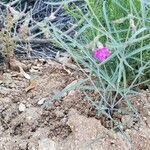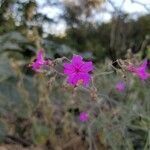Stems decumbent, ascending, or erect, sparsely leafy with few stems to very leafy and bushy branched, leafy primarily in proximal 1/5 to throughout, 1-1.3 dm, basally minutely puberulent in 2 lines, sparsely or densely spreading-hirsute, or rarely glabrate or glabrous; distally minutely puberulent in 2 lines, sparsely or densely spreading-hirsute, or rarely glabrate or glabrous, usually glandular-puberulent or pubescent in inflorescence. Leaves strongly ascending to spreading at 5-80°; petiole 0-1.5 cm; blade green to blue-gray and glaucous, linear to linear-lanceolate, rarely lanceolate, 3-11.5 × 0.1-1(-1.8) cm, thin to fleshy, thick, and succulent, base long attenuate or narrowly acute, apex acutely tapered to rounded, surfaces glabrous, glandular-pubescent, or hirsute. Inflorescences axillary and terminal, when axillary, consisting of single involucres or short branches, when terminal with ± well-defined central axis and shorter side branches, or narrowly to widely forked without main axis; peduncle 3-10 mm, usually spreading glandular-puberulent or pilose, crosswalls of hairs pale or dark; involucres pale green, sometimes tinged with purple, narrowly to widely bell-shaped, 3-6 mm in flower, 4-10(-15) mm in fruit, spreading viscid-pubescent to hirsute, 40-70% connate, lobes ovate. Flowers 3 per involucre; perianth white to purple-pink, 0.7-1.1 cm. Fruits olive brown or dark olive brown, narrowly obovate and tapering at both ends to obovoid, 3.1-5.5 mm, pubescent with spreading crinkled hairs in tufts or ± evenly distributed, hairs 0.1-0.5 mm; ribs sometimes slightly paler, slightly elevated above surface (usually less than 0.5 times as wide as high), low rounded to round-angled, 0.5-1 times width of sulci, 0.3-1 times as wide as high, smooth throughout or sometimes rugose on sides, occasionally interrupted and tuberculate near apex; sulci with small or rarely large tubercles, or low and inconspicuous or occasionally high and prominently cross-rugose.
More
Stems erect or decumbent, 3–10 dm, glaucous and commonly glabrous below the usually glandular-hairy infl; lvs linear, without differentiated petiole, rarely over 5 mm wide, glaucous, thick and succulent, becoming very wrinkled when dry; invol pubescent, 5 mm, becoming 1–2 cm wide; cal pale pink to purple, 1 cm; anthocarp narrowly obovoid, 5–7 mm, with rugose sides and smooth ridges; 2n=52. Dry or sandy soil, prairies, and barrens; N.D. (and reputedly Minn.) to Mont., s. to Tex., Ariz., and n. Mex.; intr. in Mo., and rarely adventive in e. U.S. Summer. (Allionia l.; Oxybaphus l.)
A shrub with stems that lie along the ground. The leaves are narrow and 5 mm wide. They are thick and succulent.


